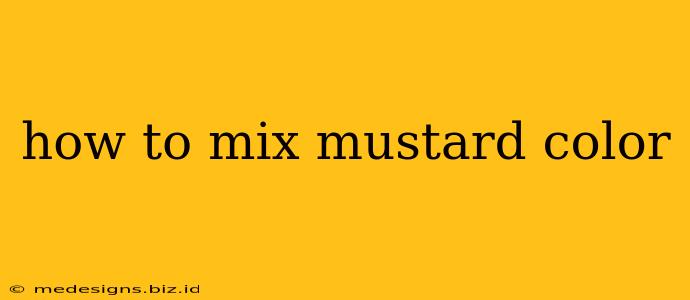Mustard yellow is a rich, earthy color that's incredibly versatile. Whether you're painting a masterpiece, crafting a unique piece, or simply need to match a specific shade, knowing how to mix mustard color accurately is a valuable skill. This guide will walk you through different methods, helping you achieve the perfect mustard hue every time.
Understanding the Mustard Yellow Palette
Before diving into mixing, let's clarify what constitutes "mustard yellow." It's not a single, definitive shade. The color can vary significantly depending on the intensity of the yellow base and the undertones introduced. Think about the range: from a pale, almost beige mustard to a deep, almost brown-tinged version. This variability allows for a wide spectrum of creative exploration.
Key Components of Mustard Yellow
Most mustard yellow mixes revolve around these core components:
- Yellow: This forms the foundation of your mustard color. Different yellows will yield different results. Cadmium Yellow, Yellow Ochre, and even Naples Yellow can all serve as excellent starting points.
- Brown: This adds depth and earthiness to the yellow, moving it away from a bright, primary yellow towards a more muted tone. Burnt Umber and Raw Umber are frequently used brown pigments.
- Red (Optional): A touch of red, like Cadmium Red or Alizarin Crimson, can warm up the mix and push it towards a more orange-toned mustard. This step is not always necessary, depending on your desired final color.
Mixing Methods for Different Effects
The precise proportions of each pigment will determine the final shade of mustard yellow. Experimentation is key! Here are some common mixing methods:
Method 1: A Classic Mustard
This method creates a standard, moderately-saturated mustard yellow:
- Start with Yellow: Begin with a generous amount of your chosen yellow (e.g., Yellow Ochre).
- Introduce Brown: Gradually add a small amount of brown (e.g., Burnt Umber). Mix thoroughly after each addition.
- Adjust and Refine: Continue adding brown until you achieve your desired level of saturation and darkness. A little goes a long way!
Method 2: A Lighter Mustard
For a paler, less intense mustard:
- Use a Lighter Yellow: Start with a lighter yellow like Naples Yellow.
- Add a Touch of Brown: Use a very small amount of brown, adding it incrementally.
- Consider a Hint of White: A tiny bit of white can further lighten the mix, but be careful not to make it too pale.
Method 3: A Deeper, More Intense Mustard
For a richer, darker mustard:
- Begin with a Deep Yellow: Use a deeper yellow base like Cadmium Yellow Deep.
- Increase Brown Proportion: Add a higher proportion of brown compared to the classic method.
- Explore Red Undertones: Consider adding a small amount of red to deepen the warmth and create a more reddish-brown mustard.
Tips for Mixing Success
- Use Quality Pigments: The quality of your pigments directly impacts the vibrancy and longevity of your mixed color.
- Mix Gradually: Add pigments in small amounts, mixing thoroughly after each addition. This allows for better control and prevents accidental over-saturation.
- Work on a Palette: Using a palette provides a clean and organized workspace for mixing.
- Test on Scrap Paper: Always test your mixed color on a scrap piece of paper before applying it to your final project.
- Don't Be Afraid to Experiment: Mixing colors is an iterative process. Don't be afraid to adjust your ratios until you achieve the perfect shade of mustard yellow.
Beyond the Basics: Mustard Color Variations
Once you master the basic methods, explore variations by:
- Adjusting the Yellow Base: Different yellows will dramatically change the resulting mustard.
- Using Different Browns: Experiment with Raw Umber or other earth tones to discover unique variations.
- Adding Greens: A tiny amount of green can add unexpected depth and complexity.
Mixing mustard yellow is a rewarding process. With practice and experimentation, you’ll develop an intuitive understanding of how different pigment combinations affect the final color, unlocking a world of creative possibilities.
